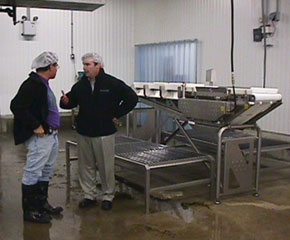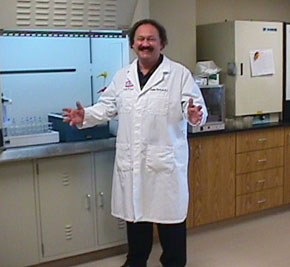Fish Food
Air Date: Week of May 7, 2004
These days, flavor isn’t the only thing restaurants need to consider when it comes to fish. Ocean pollution and over-fishing have turned some of the most popular dishes into delicacies, or in some cases, health hazards. Roger Berkowitz, president of the restaurant chain Legal Seafoods, takes us on a tour of his fish factory and lab, where every fish needs to pass inspection before making it to the platter.
Transcript
GELLERMAN: Welcome back to Living on Earth, I’m Bruce Gellerman.
[SOUND OF CYMBALS AND BRASS HORNS UP AND UNDER]
GELLERMAN: A local high school band strains to entertain tourists on this dock along Boston’s historic harbor. From here you can see Old Ironside. It’s not far from the place where revolutionary patriots turned Boston Harbor into the world’s most famous teapot. Boston’s past, present and future are inextricably linked to the sea.
Nearby, in the Capitol building hang the sacred cod and holy mackerel -- models honoring the once plentiful fish that were the colony’s first industry. Visitors to this wharf can also tour the New England Aquarium. Ironically, it’s located just across the dock from one of the busiest fish restaurants in the country, Legal Seafood.
[HUM OF CONVERSATION, CLINKING OF PLATES]
BERKOWITZ: I have a deal with the aquarium – you know, they sell me all their floaters. (LAUGHS)
GELLERMAN: Roger Berkowitz likes to joke, but he knows where his fish come from, and says so should you -- because the source and safety of seafood is literally on the line.
Berkowitz is a board member of The New England Aquarium and president of Legal Seafood. It’s a Boston institution that began with a single family-owned restaurant a quarter century ago, and now has 30 restaurants from Massachusetts to Miami. In a day, Legal Seafood serves more than 10,000 meals; in a year, 40 varieties of fresh fish -- more than any other restaurant in the country.
Just about all the fish – millions of pounds -- come here, to Legal’s holding plant at the edge of Boston Harbor, where we put on hair nets, roll up our pants, stuff our legs into rubber boots and enter a room filled with color-coded plastic vats of fish. At Legal Seafood they say, ‘If it isn’t fresh, it isn’t legal.’ You could also say if it isn’t freezing, it isn’t fresh. The plant is an icebox.
[HISS OF SPRAYING WATER, CLANK OF CRATES LOADED UP]
GELLERMAN: (LAUGHS) It’s like Antarctica in here!
|
|
BERKOWITZ: The colder you keep fish the better it maintains itself. So from the time it leaves the water and gets on a boat and is iced in, we have to make sure it’s always kept cold. It never comes in contact with heat until it goes right on the grill. GELLERMAN: Today, two-thirds of the fish consumed in the United States is eaten in restaurants. And while the average American’s appetite for seafood has remained fairly constant over the decades -- about 15 pounds a year -- there are a lot more mouths to feed than ever before. And over-fishing has lead to the collapse of many fisheries. Aquaculture, or fish farming, was once seen as the answer to the supply problem, and today a quarter of the fish served in the U.S. are farm-raised. But fish farming isn’t without its problems. It can pollute the sea, and toxins can accumulate in the flesh of farm-raised fish. So today, Roger Berkowitz says the future of the seafood industry in the United States hangs on the safety and sustainability of the resource. BERKOWITZ: I know for a fact that if I ever put Chilean sea bass on my menu it would be one of the most popular fish I’ve ever done. I won’t do it. I’ve had it before -- it tastes delicious. But it’s not a sustainable fishery. Eighty-five percent of what’s being harvested now is illegal. GELLERMAN: How much of the fish that Legal sells is farm-raised? BERKOWITZ: Hmm, Good question. We see ourselves in the business of fresh fish, and I like the additional challenge of trying to get it wild as opposed to farmed. I’m trying to wean away from farm salmon to do more with Alaskan wild salmon: A, it’s a sustainable fishery. B, I think the flavor nuances are just spectacular. Now, I still use farmed product. I use Arctic char from Iceland, a spectacular farmed product. I use some farmed shrimp because it’s a much more consistent product than I can get on a wild product GELLERMAN: There are many lists of fish to enjoy, fish to avoid. On the avoid list that I’m looking at it says, “shrimp: imported, farmed and wild” are to be avoided. BERKOWITZ: Farmed and wild. Well, you know, there’s a glut of shrimp on market right now, so why would you avoid it. GELLERMAN: They’re saying the farming of shrimp is a very polluting type of farming. BERKOWITZ: Yeah, like anything else, let’s take a look at beef. There are great beef lots and there are poor ones. There are people who farm in a very sustainable method – you know, they don’t dump the effluent out without filtering it and taking care of it – and those who do a terrible job. GELLERMAN: But how does the average consumer know that the farm-raised fish they’re buying was in a good farm or a bad farm? BERKOWITZ: Well you know, it’s interesting. Consumers have more power than they know. They have the opportunity to vote with their feet. Go into a restaurant, ask for information about it. GELLERMAN: If I went to the fish market where I go shopping, they’d look at me like I was from outer space! I mean, they’re lucky if they know if was farm-raised, let alone anything else. BERKOWITZ: Well, if there were enough people going in there and asking the question, then they’d better wise up pretty soon. GELLERMAN: To ensure safety and quality, Legal has it’s own high tech laboratory. [BEEPS, LAB SOUNDS] GELLERMAN: The place smells like the ocean. Every swordfish and tuna served at its restaurants is first sampled for mercury contamination. [WHIR OF ROBOTIC ARM] GELLERMAN: While Berkowitz says the health benefits from the fish far outweigh possible risks, the company’s mercury standards are tougher than the federal government’s. Steven Martinello carries a clipboard and wears a white lab coat. He’s Legals’ registered sanitarian. GELLERMAN: You’re a registered? MARTINELLO: Sanitarian. It’s a license you get from the state of Massachusetts. So actually you can enforce the public health laws of the state if you worked on a board of health. GELLERMAN: Steve, you’ve got your microscopes, your analyzers, your test tubes and all that. I have a kitchen. How do I know what I’m buying?
MARTINELLO: You definitely want to buy off a licensed, reputable dealer, because they are licensed and they have to be inspected. As far as mercury content is concerned, if you ask your fishmonger the origin of the tuna, the origin of the sword, would help out a lot. GELLERMAN: Where should I avoid buying it from? MARTINELLO: Well, we find that we’ve had a little bit higher counts from areas from the South Seas. But places like Panama and Ecuador, and down by the Gulf, Louisiana and real close, are very very good. GELLERMAN: What happens if you go over your limit? What do you do with that fish? MARTINELLO: We send it back. We give it back to the vender. GELLERMAN: But now he can give it back to somebody else? MARTINELLO: Hmm. Possibly, yes. There’s an action level the FDA puts for mercury, but there’s no action to go along with that action level, because the decision of how dangerous mercury is for people has not really been decided on yet. GELLERMAN: So you’re measuring this for the action level, but if it goes over that you really could do anything you want. You really could sell it legally. MARTINELLO: Yeah we could, if we wanted to. But we don’t. GELLERMAN: Infants and pregnant women are most at risk when mercury enters the food chain. That’s because mercury can damage developing nervous systems. These MOMS – that’s short for Mothers Opposed to Mercury – went to the White House with a message that the Bush Administration’s proposed rule on mercury does little to reduce that risk. [CROWD SOUNDS] WOMAN: Just like tuna fish sandwiches – that’s what I made for lunch. And to think that I’ve been harming my kids all these years without any knowledge is a little devastating. But the fact that nothing is being done about it by the Bush Administration even makes me more infuriated. [CHANTING CROWD: PROTECT KIDS’ FUTURES, NOT THE POLLUTERS! LOUDER! PROTECT KIDS’ FUTURES, NOT THE POLLUTERS!] Links
|


 Steve Martinello, Legal Seafoods sanitarian (Credit: Legal Seafoods)
Steve Martinello, Legal Seafoods sanitarian (Credit: Legal Seafoods) 



